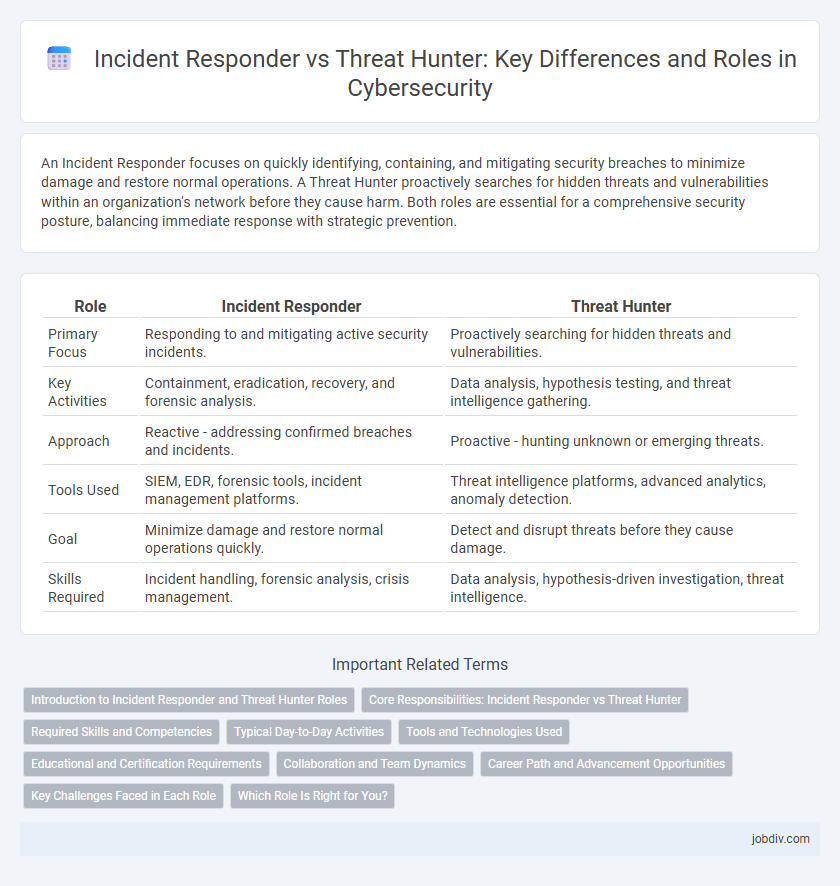An Incident Responder focuses on quickly identifying, containing, and mitigating security breaches to minimize damage and restore normal operations. A Threat Hunter proactively searches for hidden threats and vulnerabilities within an organization's network before they cause harm. Both roles are essential for a comprehensive security posture, balancing immediate response with strategic prevention.
Table of Comparison
| Role | Incident Responder | Threat Hunter |
|---|---|---|
| Primary Focus | Responding to and mitigating active security incidents. | Proactively searching for hidden threats and vulnerabilities. |
| Key Activities | Containment, eradication, recovery, and forensic analysis. | Data analysis, hypothesis testing, and threat intelligence gathering. |
| Approach | Reactive - addressing confirmed breaches and incidents. | Proactive - hunting unknown or emerging threats. |
| Tools Used | SIEM, EDR, forensic tools, incident management platforms. | Threat intelligence platforms, advanced analytics, anomaly detection. |
| Goal | Minimize damage and restore normal operations quickly. | Detect and disrupt threats before they cause damage. |
| Skills Required | Incident handling, forensic analysis, crisis management. | Data analysis, hypothesis-driven investigation, threat intelligence. |
Introduction to Incident Responder and Threat Hunter Roles
Incident Responders focus on managing and mitigating security breaches by analyzing alerts, containing threats, and restoring systems to normal operations. Threat Hunters proactively search for undetected threats within the network using advanced analytics, threat intelligence, and behavioral analysis. Both roles are critical in an organization's cybersecurity strategy, combining reactive incident management with proactive threat detection.
Core Responsibilities: Incident Responder vs Threat Hunter
Incident responders focus on quickly detecting, analyzing, and containing security breaches to minimize damage and restore normal operations. Threat hunters proactively search for hidden threats and vulnerabilities within networks using advanced analytics and intelligence to prevent future attacks. Both roles require deep knowledge of cybersecurity tools, but incident responders prioritize immediate mitigation, while threat hunters emphasize strategic threat detection and prevention.
Required Skills and Competencies
Incident Responders require strong skills in crisis management, digital forensics, and real-time threat containment to effectively mitigate ongoing cyber attacks. Threat Hunters possess advanced competencies in proactive threat intelligence, behavioral analytics, and deep knowledge of adversary tactics to identify hidden threats before they cause damage. Both roles demand expertise in network security, malware analysis, and security information and event management (SIEM) tools for comprehensive defense.
Typical Day-to-Day Activities
Incident Responders prioritize managing and mitigating ongoing security breaches through real-time analysis, containment, and recovery efforts, often coordinating with multiple teams to restore normal operations quickly. Threat Hunters conduct proactive investigations by analyzing network traffic, system logs, and threat intelligence to identify hidden adversaries and potential vulnerabilities before incidents occur. Both roles leverage advanced tools and techniques, but Incident Responders react to confirmed threats while Threat Hunters focus on uncovering latent risks to strengthen organizational defense.
Tools and Technologies Used
Incident responders rely heavily on Security Information and Event Management (SIEM) systems, endpoint detection and response (EDR) tools, and forensic analysis software to quickly contain and analyze breaches. Threat hunters utilize advanced threat intelligence platforms, behavioral analytics, and machine learning-driven tools to proactively identify hidden threats and abnormal patterns within network traffic. Both roles leverage automation frameworks and threat databases, but incident responders focus on rapid remediation while threat hunters emphasize in-depth discovery and prevention.
Educational and Certification Requirements
Incident responders typically require certifications like Certified Incident Handler (GCIH) or Certified Information Systems Security Professional (CISSP), emphasizing skills in rapid threat identification and mitigation. Threat hunters often pursue advanced training such as GIAC Cyber Threat Intelligence (GCTI) or Certified Threat Intelligence Analyst (CTIA), focusing on proactive threat detection and forensic analysis. Both roles benefit from foundational cybersecurity education, including degrees in information security or computer science, supplemented by hands-on experience in network security and malware analysis.
Collaboration and Team Dynamics
Incident responders and threat hunters form a symbiotic relationship essential for robust cybersecurity defense by combining reactive and proactive strategies to mitigate risks efficiently. Incident responders focus on immediate containment and mitigation, while threat hunters leverage advanced analytics to uncover hidden threats, fostering a continuous feedback loop that enhances threat intelligence and detection capabilities. Effective collaboration and dynamic team communication between these roles significantly improve incident resolution times and strengthen organizational resilience against evolving cyber threats.
Career Path and Advancement Opportunities
Incident responders typically start their careers with foundational knowledge in cybersecurity and progress by gaining hands-on experience in handling security breaches, which can lead to roles such as senior incident analyst or security operations center (SOC) manager. Threat hunters require advanced skills in threat intelligence and proactive threat detection, often advancing to specialized positions like threat intelligence analyst or cybersecurity strategist. Both career paths offer opportunities for growth into leadership roles, but threat hunters often transition into roles focused on strategic defense and threat mitigation analysis.
Key Challenges Faced in Each Role
Incident responders face key challenges such as rapid incident identification, containment under time pressure, and effective communication with stakeholders to minimize damage. Threat hunters wrestle with navigating vast data volumes, distinguishing genuine threats from false positives, and proactively uncovering hidden or emerging cyber threats within complex environments. Both roles demand specialized skills, real-time analysis, and adaptability to evolving threat landscapes.
Which Role Is Right for You?
Incident Responders excel in managing real-time security breaches by containing threats and restoring systems quickly, making them ideal for those who thrive under pressure and enjoy direct crisis management. Threat Hunters proactively search for hidden vulnerabilities and advanced threats within networks, suited for individuals who prefer analytical thinking and continuous investigation to prevent attacks before they occur. Choosing the right role depends on whether you prefer reactive, hands-on defense or proactive, strategic threat identification within cybersecurity operations.
Incident Responder vs Threat Hunter Infographic

 jobdiv.com
jobdiv.com